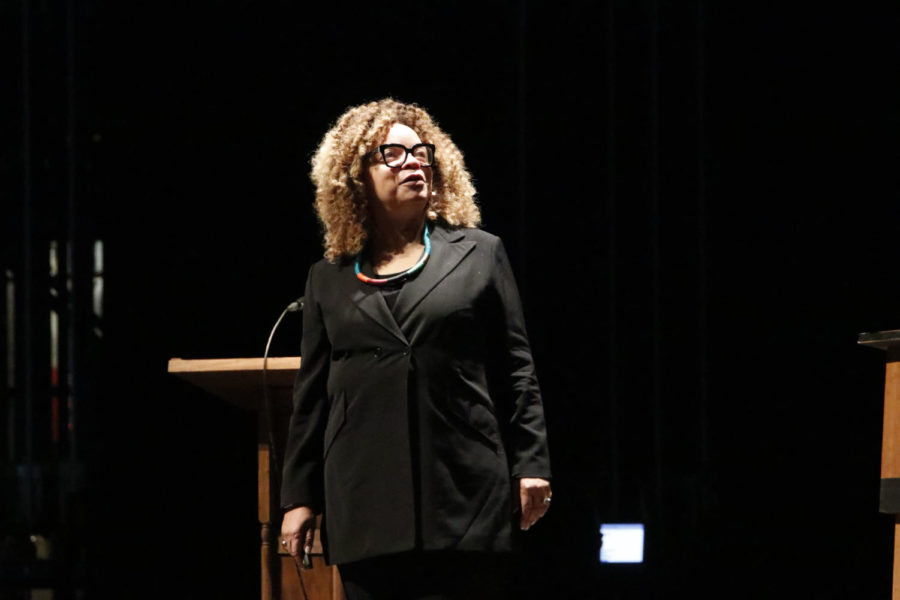‘Wakanda Forever!’ Black Panther costume designer discusses process
Gillian Holte/Iowa State Daily
Costume designer Ruth E. Carter spoke in Stephens Auditorium on Oct. 9. Carter mentioned designing costumes for superheros for the first time. “I use a lot of the same principles that I use for developing characters and coming up with their stories. I am very specific about who they are and how they look when i approach the work of black panther,” Carter said.
October 9, 2018
Two-time Oscar nominated costume designer Ruth E. Carter spoke at Stephens Auditorium Monday night about her design process for the Marvel movie “Black Panther.”
Carter opened her lecture with a short movie showcasing the “Black Panther” costumes she spent months helping to create.
She then began to take the audience into Wakanda, the fictional world from “Black Panther” that was inspired by reality.
“I have to break the news to you,” Carter said. “Sorry, you can’t go there.”
Carter said she used inspiration from African tribes to create futuristic versions of the “Black Panther” story. She showed a picture of where the film took place in Africa, showing how the movie matched geographically with tribes they used as inspiration for the design for each African tribe in the film.
“Knowing the place that you’re designing for is very important and Wakanda is a place that is located in the Northern portion of Africa,” Carter said. “And we [at Marvel] were saying that it was a place that was kind of the beginning of all of the tribes. So maybe all of the tribes of Africa, the whole continent could have stemmed from Wakanda and if that were the case, we had to include as many as we could to help tell this story.”
It was really important to geographically and historically have those details correct, Carter said.
What was unique about this film for Carter was that each character and costume had their own story, whether that story had to do with a tribe or the presumed personality of the character.
“I really loved how we added their personal stories to the costumes,” Carter said. “With the Dora Milaje, we really brought in a lots of elements of the red color of the Masai tribe, with Shuri and her lab look we created a lab look that wasn’t typical and she wore basically a lab dress and she had sneakers … it was youthful and fashion forward and still Wakandan.”
Carter also throughly researched the Marvel “Black Panther” comic books and was actually working with Reggie Hudlin, a “Black Panther” comic book writer when she found out that she would be designing for the film.
“I wasn’t a huge Marvel ‘Black Panther’ comic reader,” Carter said. “My brothers were. I was more of an Archie comics kind of a girl. So I started with Reggie. I got his ‘Black Panther’ comic and I started asking him questions about the story and learned a lot of things.”
She said she also learned a lot from Ryan Coogler, the director of “Black Panther” and huge comic book fan.
Coogler helped guide the designs in the right directions with some of the more specific details that go back to the comics.
“And that’s kind of like the beauty of when I looked at all the comics and all the versions of the Black Panther,” Carter said. “They all dealt with the story a little bit differently. So we were able to deal with it a little bit differently as well.”
Carter explained how it isn’t just one person that makes the costume designs. It takes a group of creative minds coming together and continually perfecting the process for the film.
“Being able to collaborate with a group of like-minds at many different levels like the Marvel’s team, you realize that you are just adding one layer to the development of a costume or the development of a look,” Carter said. “And somebody else is going to being another layer to it. So we all approach the subject matter with a very open mind.”
But Carter isn’t just known for her work in “Black Panther.” She is also known for working with Spike Lee on 14 films including “Malcolm X” and Steven Spielberg on “Amistad.”
“Everyone asks me how it feels to now be designing for superheroes,” Carter said. “I’ve always been designing for superheroes my whole career … Malcolm X … Dr. Martin Luther King Jr.”







